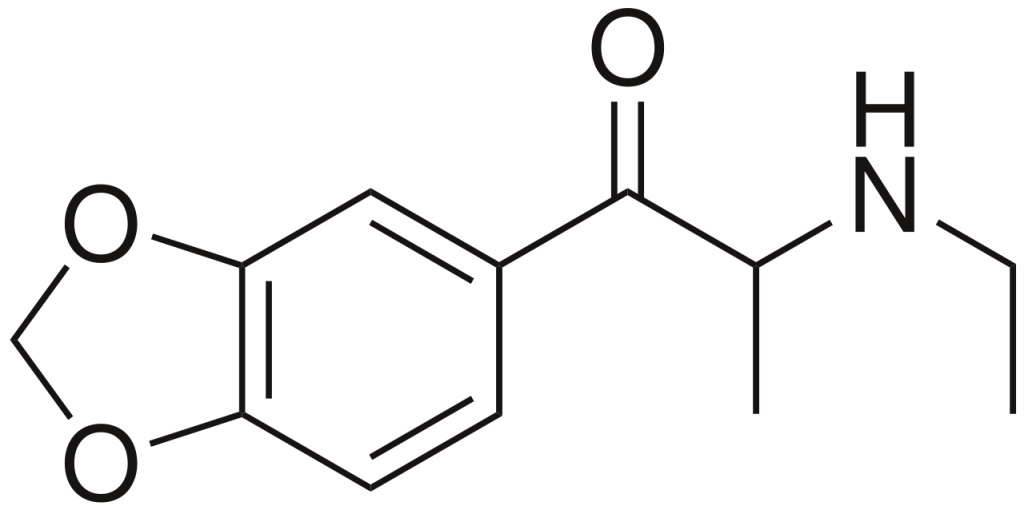Summary
Ethylone, or 3,4-methylenedioxy-N-ethylcathinone (MDEC or βk-MDEA), is a recreational designer drug with classifications in the entactogen, stimulant, and psychedelic categories. It belongs to the phenethylamine, amphetamine, and cathinone chemical classes. Ethylone serves as the β-keto analog of MDEA, commonly known as “Eve.” Notably, it has a relatively brief history of human use and is reported to have lower potency than its counterpart, methylone.
In the United States, Ethylone began appearing in cathinone-containing products in the latter part of 2011. Despite its presence in the recreational drug scene, there is a shortage of comprehensive data regarding the pharmacological properties, metabolism, and toxicity of Ethylone. It is worth mentioning that although there have been reports of deaths related to Ethylone, these fatalities were not directly attributed to the ingestion of Ethylone.
| Identifiers | |
|---|---|
| IUPAC name | |
| CAS Number | 1112937-64-0 |
|---|---|
| PubChem CID | 57252245 |
| ChemSpider | 21106271 |
| UNII | L91C78FW96 |
| CompTox Dashboard (EPA) | DTXSID20894842 |
| Chemical and physical data | |
| Formula | C12H15NO3 |
| Molar mass | 221.256 g·mol−1 |

Pharmacokinetics
Examination of human and rat urine to identify the metabolites of bk-amphetamines indicated that the degradation of ethylone followed these metabolic processes:
- N-deethylation, resulting in the formation of the primary amine.
- Reduction of the keto group to yield the corresponding alcohol.
Legal Status
By October 2015, Ethylone had been classified as a controlled substance in China.
FAQ
1. What is Ethylone?
Ethylone, or MDEC or βk-MDEA, is a synthetic recreational drug. It falls into entactogens, stimulants, and psychedelics, including phenethylamine, amphetamine, and cathinone chemical classes.
2. How does Ethylone work?
Ethylone affects the brain by altering neurotransmitter activity. It primarily influences the release and reuptake of certain neurotransmitters, resulting in increased energy, mood enhancement, and changed sensory perception.
3. What are the effects of Ethylone?
The effects of Ethylone can include heightened mood, increased sociability, and changes in sensory perception. Users may experience enhanced empathy and energy. However, individual reactions can vary widely.
4. Is Ethylone legal?
The legal status of Ethylone varies from country to country and even within regions of countries. It is often subject to regulations and restrictions, and its legality may change over time. Check local drug laws and rules before considering the use or possession of Ethylone.
5. Are there health risks associated with Ethylone use?
Ethylone use carries potential health risks, including increased heart rate, elevated blood pressure, and the risk of psychological dependence or addiction. Long-term effects and safety profiles are not well understood due to limited research.
6. Is Ethylone addictive?
Like many stimulant substances, Ethylone has the potential for psychological dependence or addiction when used regularly and excessively. Users may develop cravings and experience withdrawal symptoms.
7. How is Ethylone typically consumed?
Ethylone is usually ingested orally and is commonly found in the form of pills or capsules. Some individuals may also insufflate (snort) it, although this method can be harsh on the nasal passages.
References
- Anvisa (2023-07-24): This document, published in Brazilian Portuguese, represents Collegiate Board Resolution No. 804. It pertains to the lists of substances under special control, encompassing narcotics, psychotropics, precursors, and other regulated substances. It was officially published in the Diário Oficial da União on July 25, 2023, and provides essential regulatory information.
- Lee D, Chronister CW, Hoyer J, Goldberger BA (September 2015): This study investigates toxicological findings related to Ethylone-related deaths. Published in the Journal of Analytical Toxicology, it offers insights into the forensic aspects of Ethylone use and its potential risks.
- Meyer MR, Wilhelm J, Peters FT, Maurer HH (June 2010): This research delves into the metabolism of designer drugs, including mephedrone, and the toxicological detection of substances like mephedrone, butylone, and methylone in urine using gas chromatography-mass spectrometry. The study, published in Analytical and Bioanalytical Chemistry, contributes to our understanding of these compounds.
- “关于印发《非药用类麻醉药品和精神药品列管办法》的通知” (in Chinese): This notice, issued by the China Food and Drug Administration on September 27, 2015, relates to the regulation of non-medicinal narcotics and psychotropic substances. It provides important regulatory information regarding controlled substances in China.